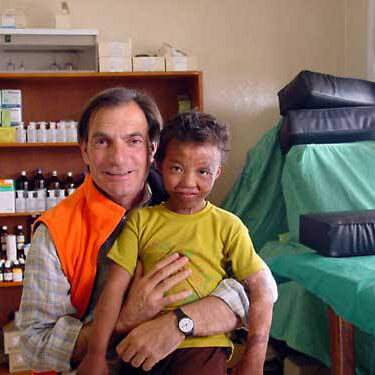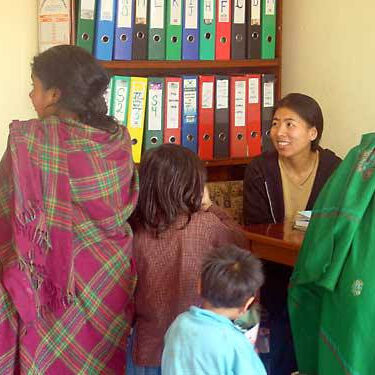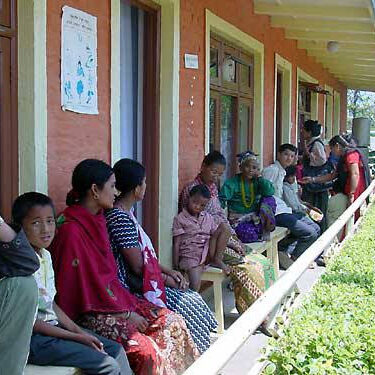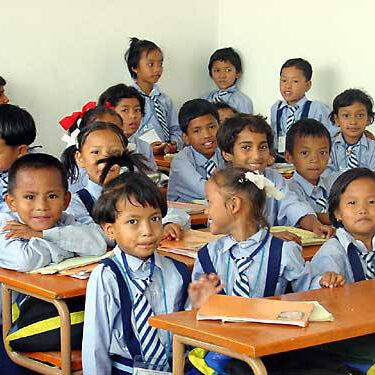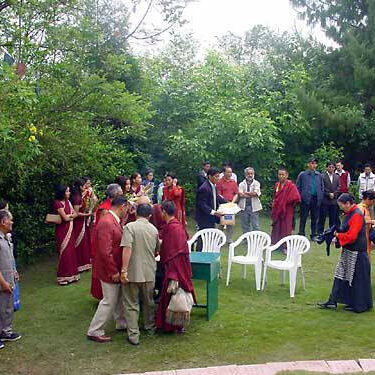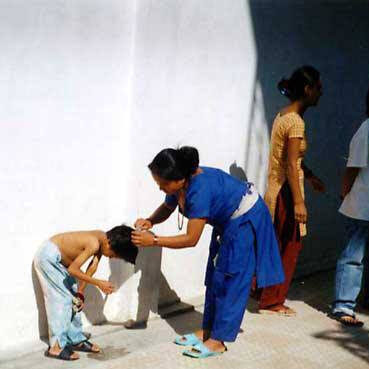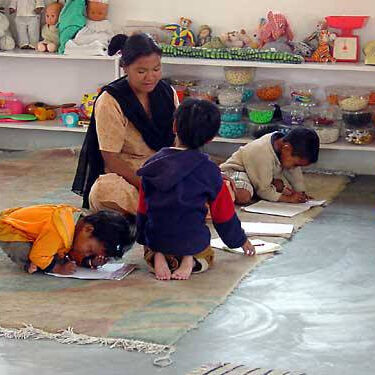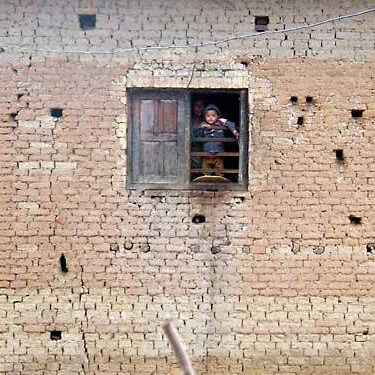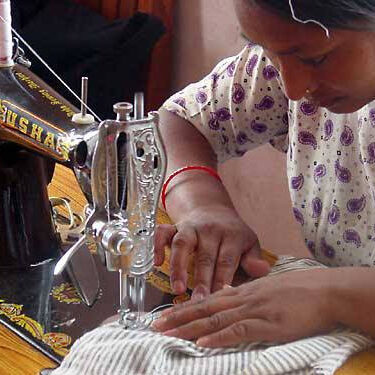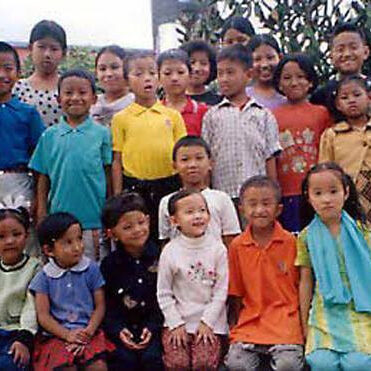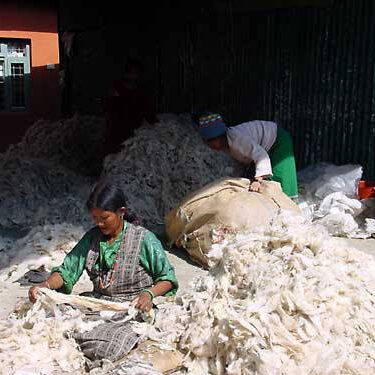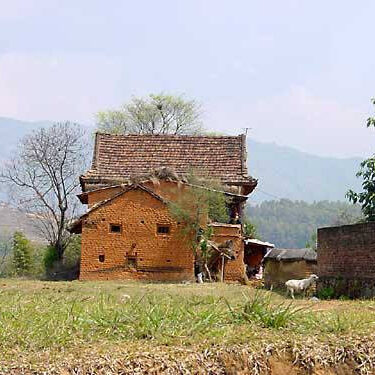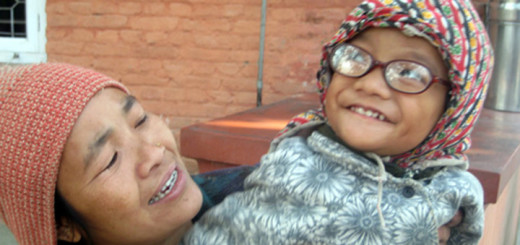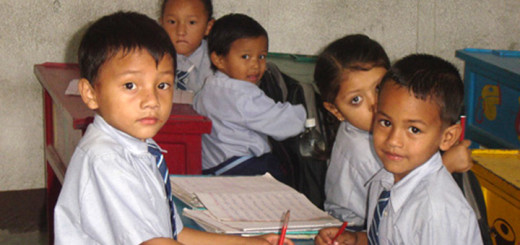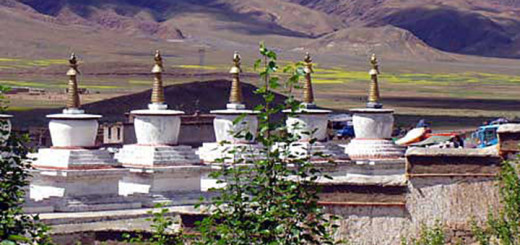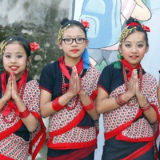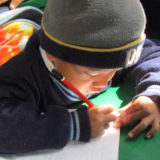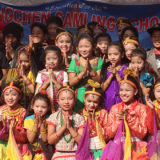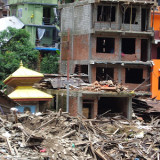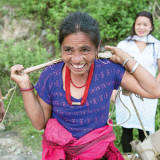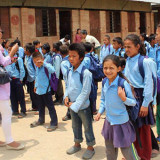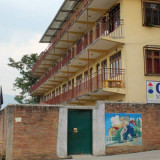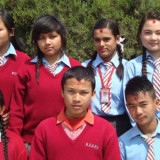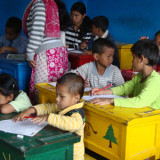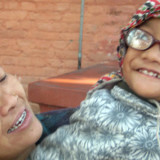Nepal 2003
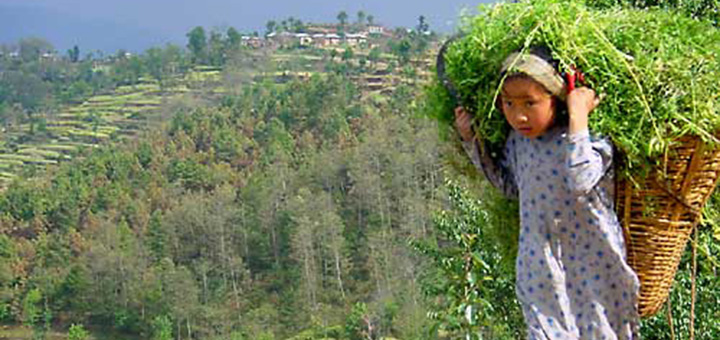
Emergency Fund
Although the Emergency Fund has many functions within the Association – helping those who are in desperate need of help and sponsoring important activities such as the family planning clinic at the Himalayan Healing Centre – we must never forget that those who we are helping are real people with real faces and real lives. The benefits of the Emergency Fund reach countless people, here are shown just a few cases.
Help in Action Office
The office of Help in Action is situated within the grounds of the Himalayan Healing Centre Complex. From here two part time staff are responsible for taking care of approximately 1000 local families who are sponsored through the Association. The office is open six days a week and is a favourite play area for many of the local children who make use of the supplies of coloured pencils, pens and paper to write to their sponsors. The office also has a small collection of toys and books to keep the children occupied. Tsering and Dolma who staff the office are responsible for collecting and translating letters, liaising with the local schools and the Clinic, distributing donated clothes, dealing with new requests, keeping accounts and collecting bills, accompanying sponsored children to hospital for medical care if their parents need help, dealing with enquiries from sponsors, solving problems…
The office is also responsible for distributing money from the emergency fund and an increasing number of people queue everyday to request help for medical care, surgery, housing, education and even food!
As in previous years some sponsors from Italy, Spain and England decided to pass their holidays in Kathmandu to get to know their children and the rich culture to which they belong.
Himalayan Healing Centre Clinic
Situated in the outskirts of Kathmandu, the Clinic has offered primary medical care and support to the poorest and most needy of the local area since 1994. Set in a beautiful garden the main building, composed of 5 examination rooms, offers a range of facilities from general medicine to traditional Himalayan herbal medicine, family planning to basic laboratory facilities, a fully equipped dental studio has also proven over the years to be a major attraction for the local population.
A smaller building houses an office for the registration of patients, pharmacy (including some donated western medicines which are given free of charge) and is the base for a local DOTS tuberculosis programme.
In 2002, an impressive 16041 people were treated in the Clinic. The majority of these people used general medical or family planning facilities, 5354 and 3825 patients respectively. The dental clinic treated a total of 3710 patients, 830 people used the laboratory facilities, 58 followed the DOTS programme and 2264 children are currently registered on the immunisation programme aimed at eradicating preventable diseases such as polio and measles.
The Clinic is also involved in other on-going community heath programmes and has hosted and sponsored various health awareness activities.
The Clinic receives every year volunteer doctors, nurses, therapists and dentists from European countries who offer specialised services such as ophthalmology, homeopathy and physiotherapy.
Gangchen Samling School
Once underway the building of the three-floor Gangchen Samling School took place in record time. The main aim of the architects and construction team was to have the doors open in time for the new Nepalese scholastic year starting in April 2003. Even though the building literally grew before our eyes, the work on the school was not completely finished in April and to avoid the dangerous combination of children and building sites, classes began on time but inside the main building of the Himalayan Healing Centre.
With an emphasis on providing a safe and comfortable environment for children to study in the building was designed with sturdy railings, fitted doors and large windows to let in light but retain heat (a rarity in Nepalese schools that usually have open brickwork and doors that let in light but also the cold). Each floor has tiled toilet and washing facilities with running water and a water filter fitted to the roof ensures that the children have access to clean drinking water (more rarities in Nepalese schools).
The school, painted a bright sunny colour has also managed to find a balance between providing paved areas for games and physical education and areas where children can play in the natural shade of green trees and see brightly coloured flowers.
But even more important than the physical environment is the motivation of the school’s sponsors: «to provide a decent education for the poorest children of the area». In fact, in its first year of life the school has already enrolled 250 children – many of whom have been offered free places as their parents are unable to afford the monthly tuition fees – and the number is expected to rise in the next year. The school presently offers nursery facilities in Samling Nursery and infant classes 1 to 5.
Gangchen Samling School – Inauguration
The official inauguration ceremony of Gangchen Samling School took place in May 2003 in the presence of local dignitaries and staff members. As groups of interested people and future students gathered on the lawn outside of the school, monks from a local monastery performed pujas (ritual prayer ceremonies) to bless the building: increasing positive energies and protecting it from negative influences. The school was then opened for inspection by local people and students.
Health and Hygiene Day
Saturday the 15th of November was a very busy day for the staff and pupils of Gangchen Samling School. The day, dedicated to health and hygiene, ensured that all pupils had a full medical check-up by doctors from the Himalayan Healing Centre Clinic as well as a free hair cut for those who wanted!
Samling Nursery
Samling Montesori Nursery has been offering free nursery education for over a decade to the children of carpet weavers. Since many years, local schools have praised the nursery as one of the best in the area, reporting that children starting their education in this school are brighter and better prepared for study than others. The children start their day with dance and exercises in the garden and thanks to the high teacher-pupil ratio children are divided into small groups where they follow the Montesori educational system and receive individual attention. Plenty of chance is given to the children to play and the nursery is one of the most well equipped in the area thanks to donations of books and toys from Europe and America, the skills of local craftsmen who have made jigsaws, letter boards and so on and the fantasy of the teachers who have created learning materials and games.
Setting a Scene
Nepal is famous throughout the world as being home to 8 out of 10 of the world’s highest mountains. This landlocked country, nestled in the impressive Himalayan mountain range, has since many years been a choice destination not only for climbers and mountain lovers but also for those in search of spiritual knowledge and peace. Nepal has an ancient culture, rich in spirituality and traditions, which has attracted travellers and tourists from the entire world. These photos have been chosen deliberately to take attention away from the usual images of Nepal used by the tour operators and bring it to the normal everyday life and environments of the Nepalese people.
Vocational Training
This year a group of single mothers – with children sponsored through Help in Action – have been given the wonderful opportunity to participate in a vocational training programme. The women, chosen due to their particularly difficult conditions, now have the chance to better their own situation by learning skills that will allow them to work independently and earn their own money. The one year full time course, that also teaches basic literacy and maths (necessary for pattern making), gives the women an opportunity to receive practical training from local qualified tailors. The women receive a monthly allowance that gives them a chance to follow the course without the additional worry of having to earn money to feed their families. Childcare for the younger children is provided on the premises.
As well as making clothes for themselves and their children during the course, other clothing samples made for practice are donated to the most needy of the local community through the Help in Action office.
A number of local tailors are saving material off cuts for the programme and the teachers have devised numerous ways of practicing skills without wasting precious materials such as sewing ruffles out of newspaper.
After the completion of the course it is planned to loan the women money to buy the necessary equipment to set up their own businesses. A sewing machine costs approximately US $70. The Association also hopes to give the work of making school uniforms and sweaters to mothers who successfully complete the course.
The programme is having great success and there is a long waiting list of people requesting places on the next programme due to start at the beginning of next year.
Group Photos
These are just some of the fortunate children who, thanks to the adoption at a distant project, have a chance to attend school and have hope for a brighter future.
Work
These photos have been chosen to represent some of the most common types of work available in Nepal. The terms butcher, waiter, fruit shop owner, wool roller and metal worker may take on a new light after seeing these photos!
Homes and Houses
Home to most Nepalese people living in the city is a small one-roomed brick structure where the entire family live, work, cook and sleep together. Houses are commonly without light and water: toilets are shared by entire communities and water has to be collected from water pumps often situated far away from the home. Houses in the countryside, although somewhat larger, are also used to house animals and harvests.

